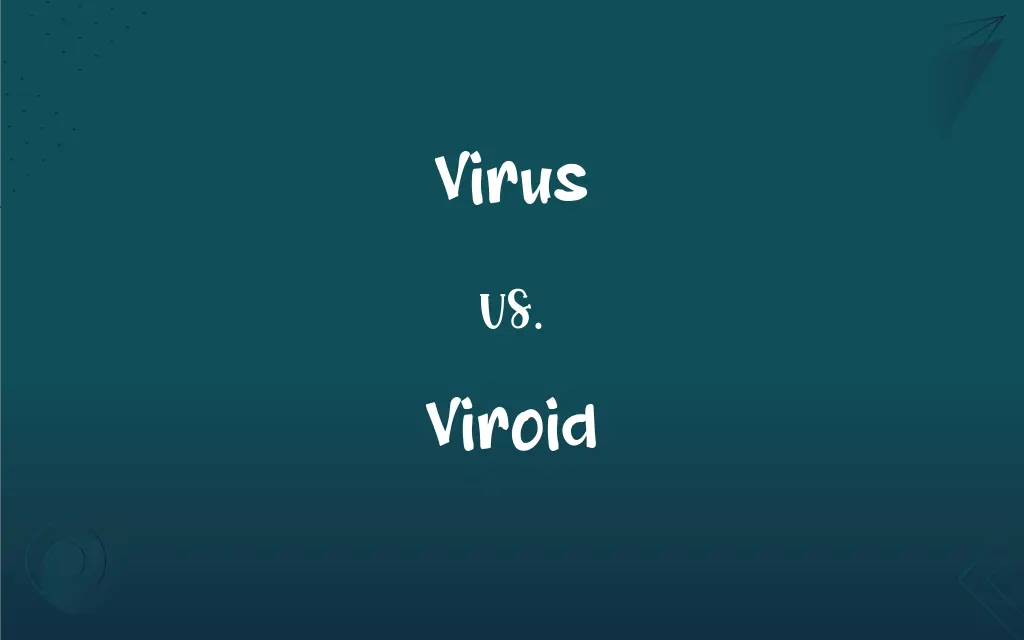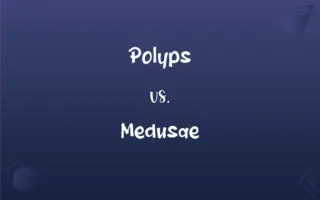Virus vs. Viroid: What's the Difference?
Edited by Aimie Carlson || By Harlon Moss || Updated on October 7, 2023
Virus: Pathogenic entity composed of nucleic acid within a protein coat. Viroid: Smallest infectious pathogen, composed of a short, single strand of RNA without a protein coat.

Key Differences
Virus and viroid represent distinctive classes of infectious agents that propagate by exploiting host cellular mechanisms, yet they encapsulate unique attributes in their structures and infection strategies. A virus is an infectious agent comprising genetic material (either DNA or RNA) enveloped in a protein coat, known as a capsid. Viroids, conversely, embody simplicity, being solely composed of a short, single-stranded circular RNA molecule, devoid of the protective protein coat that is characteristic of viruses. Viruses typically infect various organisms, including animals, plants, fungi, and bacteria, while viroids are principally known to infect plants, causing numerous plant diseases.
The structural variance between a virus and a viroid fundamentally impacts their interaction with host organisms and their subsequent pathogenic manifestations. Viruses must encapsulate their genetic material within a protein coat because their nucleic acid alone is typically insufficient to induce infection without the biochemical functionalities facilitated by the encapsulating proteins. Viroids, devoid of a capsid, navigate infections without such protective and facilitative protein envelopment, driving infection through their RNA, which can interfere with host cellular processes and consequently cause disease, particularly in plants.
Viruses and viroids exhibit notable differences in their replication processes within host cells, owed largely to their structural divergences. Viruses, after infiltrating a host cell, often utilize the cell's machinery to replicate their genetic material and synthesize protein subunits for new viral particles, which are then assembled and typically released to infect new cells. Viroids, conversely, lack coding capacity and therefore do not encode proteins; their replication in host cells is typically mediated through host enzymes, which recognize and inadvertently propagate the viroid RNA, contributing to the spread of the infectious agent within the plant.
In regard to the genetic material, viruses and viroids harbor additional differences. Viruses may contain either DNA or RNA as their genetic material, and this nucleic acid may be single-stranded or double-stranded. In contrast, viroids exclusively contain single-stranded RNA. Moreover, the RNA of viroids is often of a much smaller size compared to the genetic material found within viruses. This simplification in the genetic material of viroids contrasts starkly with the variability and complexity observed in the genetic materials of viruses.
Examining their impacts on global health and agriculture, viruses and viroids pose substantial challenges and threats in different contexts. Viruses, given their ability to infect a wide array of organisms, significantly impact global health and can cause pandemics in human populations, as well as diseases in various other organisms. Viroids, while constrained to plant hosts, can significantly impact agriculture by compromising crop health and yields. Both present ongoing challenges for scientists and health professionals aiming to mitigate their pathogenic impacts and manage their spread.
ADVERTISEMENT
Comparison Chart
Definition
A microscopic agent that can infect living organisms and contains genetic material (DNA or RNA) enveloped in a protein coat.
An infectious entity affecting plants, smaller than a virus and consisting only of RNA without a protein coat.
Genetic Material
Can contain either DNA or RNA, which may be single-stranded or double-stranded.
Contains only single-stranded RNA.
Protein Coat
Possesses a protein coat, known as a capsid, which encases its genetic material.
Lacks a protein coat, consisting only of a short strand of RNA.
Host Range
Can infect all forms of life including animals, plants, fungi, and bacteria.
Known to infect only plants.
Reproduction
Requires a host cell’s machinery to replicate and assemble new virus particles.
Does not produce proteins and uses host cell enzymes for replication.
ADVERTISEMENT
Disease in Humans
Can cause various diseases in humans.
Do not cause diseases in humans.
Size
Generally larger than viroids and have varied sizes depending on the type of virus.
Are among the smallest infectious pathogens known.
Structural Complexity
Generally more structurally complex due to the presence of protein capsids and sometimes lipid envelopes.
Simple structure with just a short RNA strand which can form a closed loop.
Virus and Viroid Definitions
Virus
Viruses have a protein coat known as a capsid, which encloses their genetic material.
The capsid of the adenovirus is icosahedral and protects its DNA as it travels between host cells.
Viroid
Viroids can move systemically through plants despite their small size and simplicity.
The chrysanthemum stunt viroid spreads through the vascular system of the plant, causing stunting and other symptoms in chrysanthemums.
Virus
A virus can infect all forms of life, including plants, animals, and bacteria.
The tobacco mosaic virus was the first virus to be discovered and it primarily infects tobacco plants.
Viroid
Viroids are the smallest infectious pathogens known.
Coconut cadang-cadang viroid, causing palm death, exemplifies the devastating impact such tiny pathogens can have on agriculture.
Virus
Viruses may cause diseases and can mutate, leading to different variants.
The coronavirus SARS-CoV-2 has multiple variants, such as Delta and Alpha, which have distinct mutations.
Viroid
A viroid is a plant pathogen composed of a non-coding, single-stranded RNA molecule.
Potato spindle tuber viroid causes disease in potato plants, leading to spindle-shaped tubers.
Virus
A virus is a microscopic infectious agent that needs a host cell to replicate.
The flu is caused by the influenza virus, which spreads easily from person to person.
Viroid
Viroids replicate in host cells using host enzymes due to their lack of coding capacity.
The avocado sunblotch viroid replicates in the chloroplasts of infected avocado cells, utilizing the host’s cellular machinery.
Virus
Viruses can contain either DNA or RNA as genetic material.
The HIV virus carries its genetic information in RNA, which is then reverse-transcribed into DNA in the host cell.
Viroid
Viroids lack a protective protein coat, contrasting them with viruses.
Despite lacking a capsid, the peach latent mosaic viroid is still able to infect peach trees and cause disease.
Viroid
An infectious particle, similar to but smaller than a virus, that consists solely of a strand of RNA and is capable of causing disease in plants.
Viroid
A short section of RNA but without the protein coat typical of viruses, that are plant pathogens
Viroid
Certain defective viruses, such as hepatitis D, a human pathogen.
Viroid
The smallest of viruses; a plant virus with its RNA arranged in a circular chromosome without a protein coat
FAQs
Can viruses infect any type of organism?
Yes, viruses can infect all forms of life, including humans, animals, plants, fungi, and even bacteria.
How does a virus reproduce?
Viruses reproduce by infecting a host cell and using its machinery to create new virus particles.
How are viruses transmitted?
Viruses are transmitted in various ways, including person-to-person contact, airborne droplets, and through vectors like mosquitoes.
What is a viroid?
A viroid is a single-stranded RNA molecule that causes infectious diseases in plants and lacks a protective protein coat.
What is a virus?
A virus is a microscopic infectious agent that requires a host cell to replicate and typically has a protein coat encasing its genetic material.
Can viruses be treated with antibiotics?
No, antibiotics are ineffective against viruses but antiviral drugs can be used to treat some viral infections.
Are viruses alive?
The classification of viruses as living entities is debated since they lack cellular structures and cannot reproduce without a host.
Can viruses and viroids be used for biological control?
Some viruses are explored for biological control against pest species, while viroids are generally not utilized due to their pathogenicity to plants.
How do viroids differ from viruses?
Viroids differ from viruses primarily by being smaller, not having a protein coat, and containing only RNA without protein-coding ability.
Can viroids infect humans or animals?
No, viroids are known to infect only plants.
How do viroids cause disease in plants?
Viroids cause disease by interfering with the plant's cellular processes, often resulting in abnormal development and reduced growth.
How are viroids transmitted between plants?
Viroids can be transmitted through infected seeds, pollen, or mechanical transmission via contaminated tools.
Can plant viruses and viroids be harmful to humans when consuming infected plants?
No, plant viruses and viroids are not known to be harmful to humans upon consumption of infected plant materials.
Can viroids be prevented or treated?
Managing viroid diseases primarily involves controlling their spread through measures like quarantine and using virus-free planting materials.
What impact do viruses have on humans?
Viruses can cause numerous diseases in humans, ranging from common colds to severe conditions like AIDS.
How can viruses be beneficial?
Some viruses can be beneficial, for instance, bacteriophages that kill harmful bacteria, and viruses used in gene therapy.
How can we identify viroid-infected plants?
Viroid-infected plants typically exhibit stunted growth, abnormal development, and may produce fewer, smaller, or deformed fruits and flowers.
Are viroids a concern for global agriculture?
Yes, viroids can significantly impact agriculture by reducing crop yield and quality.
What is the simplest form of an infectious agent?
Viroids are considered the simplest form of infectious agents due to their small size and structural simplicity.
How are viruses classified?
Viruses are classified based on characteristics like genetic material type, replication mechanism, and morphology.
About Author
Written by
Harlon MossHarlon is a seasoned quality moderator and accomplished content writer for Difference Wiki. An alumnus of the prestigious University of California, he earned his degree in Computer Science. Leveraging his academic background, Harlon brings a meticulous and informed perspective to his work, ensuring content accuracy and excellence.
Edited by
Aimie CarlsonAimie Carlson, holding a master's degree in English literature, is a fervent English language enthusiast. She lends her writing talents to Difference Wiki, a prominent website that specializes in comparisons, offering readers insightful analyses that both captivate and inform.































































